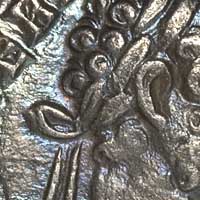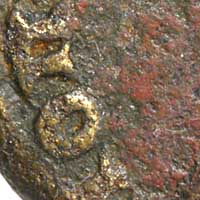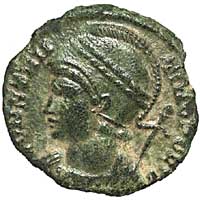| Home Page | Site Map | Useful Links | Email Me | Glossary | Next Page |
| ---------- Interesting Things About Ancient Coins ---------- |
| Colourful Patinas on Ancient Coins |
These coins have aged unusually, ending up with coloured, multicoloured or distorted surfaces. Some of them are far from the usual idea of a collectable coin, but they are just right for a photographer!
This is the obverse of a so-called "quinarius" of Allectus from 293-296 CE, showing the head of the emperor. Some detail from just behind the head is on the right.
This coin has acquired three layers of patination and the top layers have flaked off unevenly. The top layer is a slightly greenish dark brown which is a common patina on bronze coins. Under that is a layer shading between pink and orange, with a light green layer beneath. Compare this with the Gordian coin from Nicaea below, which has a green layer on top of a brown layer.
This is the reverse of an antoninianus of Valerian from around 235 CE, showing Apollo resting his hand on his lyre. A detail from this coin, around Apollo's head, is on the far left.
This is another multi-layered coin. It has has minute traces of surface silvering as well as three layers of patina. This might be officially issued, or it might be a contemporary forgery, a fourrée. In either case, the silvering of the surface has almost completely worn away.
A denarius of Septimius Severus, 194-195 CE. On the left is the obverse, showing the emperor's laureate head. The back of the head is enlarged on the right.
Unlike the others, this silver coin has probably acquired its startling appearance in modern times. The coin will have been cleaned, then built up a thin layer of toning that gives different bright colours by diffraction. The detail photo on the right was taken with flash, which shows up this effect much more strongly than shots taken with a different light source.
Toning of this sort is common on modern coins, which have not yet had time to build up any decent patination. Ancient silver coins usually have a dulled or dirty surface unless they have been cleaned.
A bronze coin of Philip II of Macedonia, 359-336 BCE. This is the reverse, showing a naked youth on a horse. A detail from the same coin, the head of the horse, is on the far left.
Greens, blues and even hints of yellow appear on this little bronze coin of the father of Alexander the Great. "Philip" means "horse-lover," and horses featured on many of his coins. A colourful horse's head is shown in the enlargement.
A bronze provincial coin of Diadumenian from Nikopolis ad Istrum, 217-218 CE. The obverse shows Diadumenian's bust. The enlargement shows detail from the area just left of the shoulder.
This bronze coin has patches of thick deep red patina creeping over its surface. Perhaps it's not as showy as some of the other coins here, but it's a nice colour and also a very pleasant and artistic portrait of this ill-fated boy emperor. (Diadumenian was made Caesar, a sort of junior emperor, by his father Macrinus, and was later given the equal top rank of Augustus, but both were killed soon after. This all happened over a 14 month period between 217 and 218 CE. Diadumenian was aged about 10 when he was executed.)
A potin tetradrachm of Aurelian from Alexandria, 274-275 CE. The reverse shows an eagle. The detail is the eagle's beak.
This coin has a more vivid, almost maroon encrustation over most of its surface, with green patina in the crevices. It is fairly dull in ordinary light, but becomes quite showy in the bright light of my photographic stage. The enlargement of the eagle's beak shows the red top layer, the green, and the underlying brown bronze patina.
These Alexandrian tetradrachms are made with an alloy which contains lead, and this deep red cover is typical of lead oxide. It therefore seems likely that the previous coin also contains some lead in its mix.
A bronze provincial coin of Diadumenian again, 217-218 CE. The reverse shows Hygeia and Asklepios.
This is a contrasting coin, with a rich jade green colour. Greens are common in the patinas of Eastern provincial coins. In the hand, the surface looks dark and plain, but close up and under a bright light, you can see that the patina of this one displays a crackle effect, very glassy, in fact looking much like a translucent green glaze on an old ceramic. The enlargement, taken with flash, is of the area just to the left of the "T" in the exergue (below the figures).
Another coin made with the same reverse die, much clearer but with a less showy patina, is on my "Salus and her Snake" page.
A bronze coin commemorating the founding of Constantinople, 334-335 CE. The obverse shows a personification of the city.
Like the last one, this little coin also has a crackle finish, but this time it's more of a snakeskin effect. It's not obvious from a distance, but it jumps out in a close-up like the one here, from the mouth and nose area. It makes the coin look like a miniature Roman mosaic.
A bronze provincial coin of Gordian III from Nicaea, 238-244 CE. The obverse shows the emperor's radiate bust. The detail is from around the eye and the bridge of the nose.
This coin has a provincial green patina again, more earthy this time, which has come away from about half of the coin, leaving a face-painting effect on top of a medium brown patina. I wonder how many different environments these coins find themselves in, to have different layers of colour so often?
A bronze AE15 from Stratonikea, 2nd-1st century BCE. The reverse shows the legendary winged horse Pegasus. The detail is Pegasus' head.
There is a startling orange-yellow patina on this rather corroded little bronze coin. The enlargement on the right is Pegasus' head. Spots of corrosion appear on the yellow patina as well as the more usual bronze patine you can see on the high points, so maybe the coin became coated with patina and then was exposed to different conditions which corroded it. This makes for a very effective image.
| The content of this page was last updated on 16 July 2009. |
| Home Page | Site Map | Useful Links | Email Me | Glossary | Next Page |



















